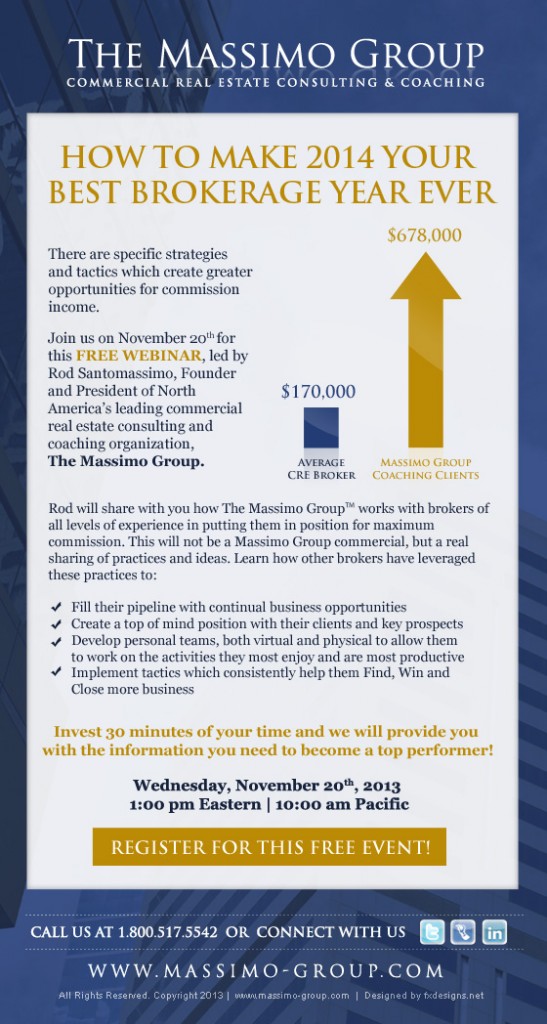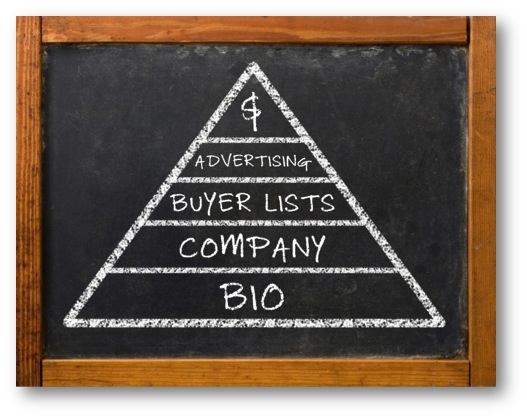Category Archives: Prospecting
How to Find Your Specialty by Answering 3 Questions
by
I am continually surprised by Commercial Real Estate brokers who lack a specialty. All top performers in CRE have a specialty. Yet, those mired in mediocrity refuse to hone in on what they can be awesome at doing. In fact, business owners of all kinds often have this problem.

Image courtesy of iStockPhoto.com
I had a call last week with one of our advisors on the East Coast. He was traditionally a specialist in hospitality. Because of some changes in his life, he needed to shift his specialty to something he could practice locally. His question was what should he specialize in. What would you tell him?
Many of my coaching clients face this question as well. It doesn’t matter if you are new to the business or you are mid-career. Making this decision correctly will have a profound impact on your career. Not only can it determine the amount of income you can make, but it can determine if you will like going to work every morning.
A CRE broker, or any business owner or salesperson, can find his/her sweet spot by answering 3 questions.
Three Questions to Find Your Specialty/Sweet Spot
1. What do you like?
You should always start here. What product type do you like? What would you own if you could? For me, I love multi-family. I love to broker these deals. I own this property type. I understand it. I don’t like industrial properties. They don’t fit my eye. I don’t enjoy being in industrial parks. It just isn’t my thing.
You need to answer for yourself – what are my favorite 3 product types? Write them down.
2. What are you good at?
This is completely different than what you like. Consider what you are good at. Do you enjoy intense underwriting and analysis? If so, multi-family might be your thing? Do you enjoy fast paced prospecting and deal making? If so, then maybe Single Tenant Net Lease (STNL) is your thing? Maybe you love evaluating how the business aspect of hospitality properties and convenient stores impact value?
Again, list what product types fit your skill set. Write them down.
3. Where is the market velocity?
I did this exercise in 2009. The market had dried up everywhere. My business was suffering. I looked around and saw that Dollar Stores were still trading at a rapid rate. That was the only market velocity I saw anywhere in Kentucky.
Now I already told you that I love multi-family and it fits my skill set. But no apartments were selling. If I would have chosen apartments as the object of my prospecting campaign, I would have failed. Instead, I began focusing on Dollar Stores. It was a great move, and I learned to love that product type.
Look around your market. Where is the transactional velocity? Write those down as well.
Now look at your lists. Where the answers to the three questions overlap is where you should specialize. This is your sweet spot.
I ask that you to do two things:
Regardless of what industry you are in, what benefits would you realize by finding your sweet spot and being known as the expert in your specialty? You can leave a comment by clicking here.
You have a friend that needs to find their sweet spot. I challenge you to email this post to them so they can do this simple exercise. It could change the trajectory of their career.
To download a free worksheet that will allow you to work this exercise and visually find your sweet spot, click the button below.
Survey: Please Help Me Choose My Book Cover
by
I am very excited to announce that I am almost finished with my first ebook. In the coming weeks, I will make it available here at BoBarron.com.
Right now, however, you can play a role in helping me choose my book cover.
Below is a simple survey with four choices. Please take 15 seconds and let me know which one you prefer. I would be so grateful!
All you need to do is click on the cover you prefer and click the button at the bottom. Thanks so much!
Do the 3 P’s of CRE Apply to You?
by
Last week, I had the privilege of being in Portland, OR for a commercial real estate conferencence. I had never been before and discovered it to be a beautiful and unbelievably clean city. I was blown away.
Our Pacific Northwest franchisees put on a great training conference. I got to speak on how to improve efficiencies with technology. I also got to lead a couple of break out sessions on measuring outcomes and accountability. It was a blast.
Curt Arthur, our managing director and franchise owner in Salem, OR said something there that I had to write about.
He mentioned in his opening remarks the 3 P’s. These are the three things that typical commercial real estate brokerages do with a new listing. He was not complimenting our industry of commercial real estate.
3 P’s of Typical Commercial Real Estate
- Put up a sign.
- Put it online.
- Pray that someone will bring an offer.
These are not bad things. A sign is a great way to broadcast to locals that property is available. Most property searches start online, so you have to make sure your listings are there. And I am a huge believer in prayer so don’t get the wrong idea here. For those of you who would substitute the word ‘hope’ for ‘prayer’ – hope is not a strategy.
This is called Passive Marketing. The definition of passive marketing is to flood the market with information on all fronts, and then wait for the phone to ring. That is simply not good enough.
But this is the norm. Too often, a seller signs a listing contract and doesn’t hear from the broker for 6 months when it’s time to extend the contract.
The other side of the coin from Passive Marketing is Proactive Marketing. Proactive Marketing is taking the initiative to ensure everyone who could be a buyer knows the property is available. That takes work. That takes a system.
So here are some questions for you to consider as you start your week. I encourage you to ponder and share your answers in the comments section below.
- Is hope your strategy?
- Will you be described this week as proactive?
- In what ways will you proactively market your listings, products, or services?
- What are the most effective ways you proactively ensure that every qualified buyer knows about your listing, product, or service?
Question: Will the 3 P’s describe you this week? You can leave a comment by clicking here.
April’s Top Posts from theBarronBlog
by
In case you missed them, here are the top posts from April on the topics of Next Practices in Life, Business, and Commercial Real Estate.
I do want to invite you to subscribe to this blog just to the right of what you are reading now. This will make it so easy for you to get my new posts without having to remember to check my site. And I will never violate your privacy!
April’s Top Posts:
The Anatomy of a Cold Call – While I don’t believe in scripts, I do believe in crafting your opening statement before you call. Most salespeople have the most problems with how they start the call. ”Uh, hi. My name is Bo Barron and I’m with ABC Co. Uh….how’s it going?” Terrible! Read more…
The 5 Steps of the Initial Meeting – With some experience and some great coaching, I learned a better way. Remember, if you are following my system, this initial meeting should be short. Actually, you told the prospect that it would be short. If you connect and the prospect starts asking questions – great. You may be there 2 hours. However, you told them short. Prepare for short as you are making an impression as someone with integrity…or not. Read more…
The Winning Presentation – You have now landed a meeting to make a listing presentation (or whatever presentation applies to you). You have worked through the entire prospecting process to get to this point. Your put in the work becoming a market specialist. Building a database. Sending letters. Making cold calls. Conducting the needs analysis. It has all led to this moment. You sit in front of the prospect. The business is there for the taking. You have the privilege of potentially improving the life of the person in front of you. What do you do? Read more…
-
Why Do We Fall? [Video] –This week I had the privilege of traveling to Salisbury, MD to visit SVN Miller Commercial. This group is the Sperry Van Ness 2012 Firm of the Year. They are a study in how to build a team with incredible culture. They like each other. They have tradition. They have camaraderie. They absolutely dominate their market.
I had the pleasure of training their entire company primarily on prospecting. At the end of our afternoon together, Brent Miller played this video. I was so moved that I wanted to share it with you.
Clarity Series – Prospecting – Summary & Conclusion – When I was 15, my dad hired me to clean out a concrete drainage ditch. That ditch ran behind the houses of a street he had developed. We agreed on a price and I started digging. I soon discovered that I could hire my friends at a rate higher than minimum wage. I made all the income when I did the work. I made half that amount when they did the work. Read more…
Thank you so much for reading. Towards the end of May, I will be introducing another Clarity Series on Presence. As always, I’d love to hear from you in the comments section.
Question: What is the single most important activity that drives your business? I challenge you to articulate and explain your answer in the comments below.
CS: Prospecting – The System Summary & Conclusion
by
The Clarity Series (CS) is a series of posts all on one subject. This particular subject is prospecting. While the context is commercial real estate, these steps and principles can be applied to any sales. To read the introduction of this series, click here. To read an overview of the entire prospecting system, click here. Thank you for reading!
When I was 15, my dad hired me to clean out a concrete drainage ditch. That ditch ran behind the houses of a street he had developed. We agreed on a price and I started digging. I soon discovered that I could hire my friends at a rate higher than minimum wage. I made all the income when I did the work. I made half that amount when they did the work.
It was an epiphany for me. I made money by providing work for my friends. It cost me no time. Instead, I would mow yards. It multiplied what I could make. As I look back, this was the summer I was bitten by the entrepreneurial bug. The other thing I learned that summer was digging ditches is no fun!
So let me ask you a question. If I paid you a million dollars to dig a ditch, would you not do it?
Prospecting is much like digging a ditch. It is no fun. However, it is the path to substantially increasing your income? If I paid you a million dollars to prospect, would you not do it? This is your choice every day when you decide how to spend your time.
Dig your ditch! Here is a recap of how to do it.
How to Dig Your Ditch
1. Introduction to the Clarity Series on Prospecting
2. Choose your Geography and Specialty
This wraps up the Clarity Series on Prospecting. My hope is that you will now have actionable steps to implement into your business. Adopt the mindset that someone is paying your a million dollars to dig this ditch. Systematize your prospecting. Delegate every task you can. Make the calls! Do this and join the 5% of top performers. Nothing is holding you back except…you.
There are more Clarity Series topics to come in the future, but I want to hear from you. What topics would you like to read about in more depth? Comment below!
CS: Prospecting – The Winning Presentation
by
The Clarity Series (CS) is a series of posts all on one subject. This particular subject is prospecting. While the context is commercial real estate, these steps and principles can be applied to any sales. To read the introduction of this series, click here. To read an overview of the entire prospecting system, click here. Thank you for reading!
I was an Arabic Linguist in the Marine Corps. Those with my job specialty went one of two paths. They deployed in support of infantry units, or they were sent to a support battalion state-side. Those units did not deploy. I was placed on the second path.
My mom was thrilled as was my wife. I was not. I would volunteer for every deployment (they never sent me). I wanted to go and do the job.
I compare this to faithfully studying for a test. You have put in the work. You are ready. You know that you will come through when it matters at test-time. You are confident that you will ace it. But you never get to take the test. That is what it was like for me. I had put in the work and needed to take the test.
You have now landed a meeting to make a listing presentation (or whatever presentation applies to you). You have worked through the entire prospecting process to get to this point. Your put in the work becoming a market specialist. Building a database. Sending letters. Making cold calls. Conducting the needs analysis. It has all led to this moment. You sit in front of the prospect. The business is there for the taking. You have the privilege of potentially improving the life of the person in front of you.
What do you do?
Normal Listing Presentation
Before we get into what the winning listing presentation looks like, let discuss the industry standard.
The industry standard listing presentation is broker-centric and follows the sequence in the picture.
- Bio – the broker talks about how awesome he is. The prospect gets to hear the bio, breadth of experience, etc.
- Company – the broker then talks about the company. They have been serving their clients faithfully for 45 years, etc.
- Buyer Lists – My database is bigger than anyone else’s. This is the claim that kills me. There is no way that any one firm knows all the potential buyers for the property. It is simply impossible. But this is the claim.
- Advertising – Explanation is given to how the property will be marketed. They promise to pre-screen all buyers to not waste the prospects time, etc.
- The property – Finally, the broker gets around to discussing something that effects the prospect – their property! The broker takes the seller through the underwriting and analysis.
- Listing Agreement & Commission – Once the broker has made the case for how awesome she and the company are, and explained how they will produce the sure-fire buyer, they make the case for their fee and negotiate the listing agreement.
Note that the prospect must sit through a presentation that has little to do with them and everything to do about the broker and his/her company. Often, the prospect has 4 of these back to back in an afternoon. The last broker in should bring a six pack.
Winning Presentation
In contrast to the broker-centric presentation, the winning presentation is all about the prospect.
- Start by connecting – You have already had the needs-analysis interview so you know what the main concerns and highest interests of the prospect are. Start there. Demonstrate that you were listening. Assure the prospect you have custom crafted your presentation to meet those needs. Discuss with the prospect your conclusions about the property and demonstrate how you got there.
- Explain your action-plan – As your prospect has specific needs, explain how you are going to meet those needs. Think of all your capabilities as the proverbial toolbox. Which tools are you going to pull out and use together to accomplish the goals of your prospect.
- I have, I am, and I will do – Now share with your prospect a deal story where you have accomplished a similar feat before. Use the “I have, I am, and I will do” method. I have accomplished this before. I am working to accomplish this right now with other clients. I will be able to do so again for you.
- Close – Summarize the key points of your presentation. Emphasize your understanding of the prospect’s situation. Show how you custom solution will accomplish the prospect’s goals. Then ask for the business! Don’t forget to actually ask. Too many salespeople stop just before this point.
I realize that this is over-simplified. But what do you do to win the business? What are your key steps to a winning presentation? Share those thoughts in the comments section.
CS: Prospecting – The 5 Steps of the Initial Meeting
by
The Clarity Series is a series of posts all on one subject. This particular subject is prospecting. While the context is commercial real estate, these steps and principles can be applied to any sales. To read the introduction of this series, click here. To read an overview of the entire prospecting system, click here. Thank you for reading!
Over the last couple of weeks, we’ve discussed the first 5 steps of the killer prospecting system: geography, specialty, database, use the mail, and make the dang cold call. You have done these 5 steps and now have a meeting with a prospect. Here is what I used to do.
I would go into the meeting guns blazing about why me, why my company, and why now. It was all about me. I would give my canned listing presentation. I would use this on a 2 acre piece of raw land just like I would with an $8MM apartment complex. I cringe thinking about this.
With some experience and some great coaching, I learned a better way. Remember, if you are following my system, this initial meeting should be short. Actually, you told the prospect that it would be short. If you connect and the prospect starts asking questions – great. You may be there 2 hours. However, you told them short. Prepare for short as you are making an impression as someone with integrity…or not.
5 Steps of the Initial Meeting
Your purpose in this meeting is two-fold. First, you need to find out if there is a problem or an opportunity. Second, you want to leave with an appointment for a second, longer meeting. This second meeting is where you will make your proposal. Here is how to pull it off.
- Ooze Gratitude and Excitement – Too many brokers or salespeople act too cool. If you have done your homework and worked the system, then you are sitting with someone who you want to do business with. You are sitting across from someone who you have pursued. Don’t act like you could care less. Show the prospect that you are excited. Let them know that you are thankful they have given you some time. Gratitude and manners go a long way. “Mr. Prospect, I lost sleep last night I was so excited about meeting with you today. Thank you so much for the time.”
- Arrive Bearing Gifts – To get the meeting, you may have offered them something of value – information on a comparable sale effecting their property’s value, etc. Be sure you have it. It is likely they aren’t meeting with you because of your reputation. Deliver this information in the context of a story. Stories are a great way to communicate the emotion of the deal. It will help you connect with the prospect.
- Make the meeting about them – This is contrary to a salesperson’s natural inclination. Don’t drone on about your experience or your company. You should have researched the prospect. Try to quickly connect around some common ground. Did you go to rival colleges? Do you have children of similar ages? Ideally, you will be in their office. This gives you the opportunity to see pictures, awards, diplomas, etc. Pay attention to detail.
- Ask Great Questions – Here is where you are trying to uncover motivations that could lead to a transaction. Better stated – you are trying to uncover opportunities to serve the prospect and build trust. Asking open-ended and insightful questions is how you will do it. Try to find area of frustration or pain. Ask them what keeps them up at night regarding their property. The answer could be about an opportunity they are excited about. It could also be about pain they are having. Ask them about frustrations they have had with previous broker relationships. The answers to these questions are gold. This is the information you will use to prepare your customized proposal to win their business later.
- Ask for the next meeting – Now that you have conducted your needs-analysis meeting, ask for the next meeting. Explain that you will need a little more time for the next meeting to propose how they might achieve their highest interest (this is the same highest interest you learned in step 4). Once you leave with an appointment, it is now time to prepare for your proposal.
What are your thoughts about an initial needs-analysis meeting? What are some questions that you would ask? Please leave your comments below!
March’s Top Posts – Prospecting
by
In case you missed them, here are the top posts from March on the topics of Next Practices in Life, Business, and Commercial Real Estate.
I do want to invite you to subscribe to this blog just to the right of what you are reading now. This will make it so easy for you to get my new posts without having to remember to check my site. And I will never violate your privacy!
March’s Top Posts:

via iStockPhoto
The Purpose of a Cold Call – The purpose of a cold call is very simple and there is no debate. It is to get a meeting. That’s it. It is not to spend 20 minutes on the phone. It is not to build a lasting relationship. It is not to make the sale. The purpose of the cold call is simply to get a meeting.. Read more…

iStockPhoto
How to Write a Prospecting Letter – So, here is a not so short letter to my children. I share this because I believe intentionally communicating with our children what they should know is a great idea. Tomorrow is the first day of the rest of my life, but it could also be my last. I want to intentionally take steps to share certain things with my children that could make a huge difference in their lives. I share this to encourage you to do the same. Read more…

Don’t I look smart? My wife thinks so!
Introducing the Clarity Series: Prospecting – Clarity is such a powerful thing. It allows you to act with direction and focus. It gives you the ability to maximize your efforts and your results. Clarity of purpose allows you to say ‘no’ to good things and ‘yes’ to great things.
I am introducing the Clarity Series. Let me explain what the Clarity Series is.

iStockPhoto
Preparation for a Cold Call – I recommend that you take 2-3 minutes before you make a call and see what you can find out about your prospect. There is way too much information out there not to. Your goal is to find something quickly that you can use to establish common ground. Remember, cold-calling is a numbers game. Don’t spend too much time researching your prospect. And don’t spend too much time on the call itself. Read more…

iStockPhoto
5 Steps to Build a World-Class Database – In 2004, I got out of the Marine Corps and moved home with my family. The next day, I started working with my dad in his CRE brokerage business. As we would be driving around town, he would share with me the histories of the properties we drove by. He knew everything. He knew who owned the property. He could tell me what they paid for it. He could tell me how big they were. We would pass some properties he had sold multiple times. He defined encyclopedic knowledge of a market. I remember thinking that I would never get there. Read more…
Thank you so much for reading. April will continue the Clarity Series on Prospecting. We will then get into how to create a dominating presence in any market. If you have any ideas on what I should write about, please leave your suggestions in the comments below.
CS: Prospecting – Anatomy of a Cold Call
by
The Clarity Series is a series of posts all on one subject. This particular subject is prospecting. While the context is commercial real estate, these steps and principles can be applied to any sales. To read the introduction of this series, click here. To read an overview of the entire prospecting system, click here. Thank you for reading!
In the last two posts, we have discussed the purpose and philosophy of cold calls as well as how to gain confidence by solid cold call preparation. In this post, we are going to talk about the ideal anatomy of a cold call.
Anatomy of a Cold-Call
Opening Statement – Mike Lipsey calls this the IBS – initial benefit statement. The key here is to get right to the point. Communicate quickly and with clarity why taking this call will benefit the prospect. In Part 2 of this post, I discussed that you want to find the prospect’s website. What you are looking for is their mission statement, core values, etc.
For example, let’s say the prospects mission statement is to “Add value to the lives of our clients by providing unmatched products and world-class service.” Your opening statement could then be:
“Mr. Prospect. My name is Bo Barron. The purpose of my call is to help you add value to the lives of your clients by providing you with world-class service and unmatched expertise.”
Notice that I didn’t completely plagiarize their mission statement, but I’m talking the language of the prospect. The prospect will know that I’ve done my homework.
While I don’t believe in scripts, I do believe in crafting your opening statement before you call. Most salespeople have the most problems with how they start the call. “Uh, hi. My name is Bo Barron and I’m with ABC Co. Uh….how’s it going?” Terrible!
Knowing your opening line will give you confidence. It will also grab the attention of your prospect. This will give you a much better chance of landing the meeting.
Follow Up Question – Once you have gained the prospect’s attention with a killer opening statement, it is now time to ask the perfect question. What is that question, you ask? It is one that gets the prospect talking. If you can get them talking about a problem or an opportunity – even better. Here are some sample questions:
- What problems are you having with your vacancy?
- Many owners are struggling with their management. What difficulties are you having?
- When you purchased this property in 2004, what were your thoughts about how long you would keep it?
- I see that you own 3 properties in this area. What are your continuing growth plans?
- How long do you feel like your current capacity can handle your growth?
I suggest that you have two questions ready. If you bomb with the first, then you are ready to fire with the second. Also, human dynamics make it very difficult to say no twice. That is why a door-to-door salesman always has a second item to sell you when you shoot down the first.
And do not ask ‘yes/no’ questions. They will tell you no. Ask the prospect a question that leads them to share a little bit about their property, their plans, their frustrations, etc.
Value for Free – Here is where you can set the hook. Have something of value to offer the prospect for free. This could be a market report, trend report, or something in the news that could affect their property. The best thing, though, is a comp. Ideally, you have just sold something in the neighborhood. Owners want to know about deals that have happened. They want to know the details. They want to know who was involved. If you have that information, they will talk to you and meet with you.
Your thinking should be, “Even if I don’t uncover a possible relationship or transaction, this prospect is going to gain something valuable from taking my call.”
Close for the Meeting – At this point, you have shared with them the purpose of your cold call. You got them to share a little bit about their property or their business. Now you have piqued their interested in some information that you have. Now it is time to close.
Most of you stop here. Don’t. You have to ask for what you want. Ask for the meeting!
Now, you have just offered the prospect information that they want. Do not give it to them over the phone. Do not email it to them. Require that they meet you face to face. But make the requirement as whimsical and gentle as possible. I use the assumptive and alternative calendar closes the most.
First, I assume the prospect will meet with me. Then I give them two different dates and times that I can “pop by.”
- I like the alternative calendar close because the answer to the question is not “no.” I am asking the prospect to choose between two dates and times. This increases the likelihood of a positive answer.
- The term “pop by” is one I learned from the book How to Master the Art of Selling by Tom Hopkins (affiliate link). This is a great book on the tactics of selling. The term “pop by” just sounds quick – like you will just be there for a few minutes. Maybe you will. Regardless, it is easy for the prospect to agree to.
Within these 4 steps of the anatomy of a cold call, the conversation can go anywhere. You need to be ready to improvise and go where the cold call may take you. But remember, you have to actually ask for what you want. Ask for the short meeting.














